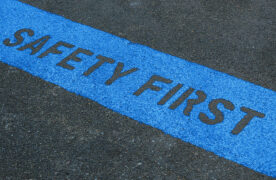Reviewed by Detective Constable Chris Auger of the OPP Drug Enforcement Unit, Prescription Drug Diversion
The College recently published an article on Preventing Drug Diversion, focused on the responsibilities that pharmacies have to prevent opportunities for diversion of controlled substances (narcotics, controlled drugs and targeted substances).
Pharmacies must also be aware of the potential for robberies, particularly by those in search of narcotics, which may then be trafficked. While there is nothing that can absolutely prevent a robbery, there are measures that pharmacists, pharmacy technicians and pharmacy managers can take to decrease the risk and protect staff and property. Pharmacies are also encouraged to work with their community partners, including police, to assist with deterring offences and contributing to a successful resolution of investigations.
Please note that the College cannot offer specific recommendations or directions for pharmacy security. The following are considerations that can be taken into account when assessing security at the pharmacy.
PREVENTING ROBBERIES
Look for opportunities to make the pharmacy a less attractive target.
Consider the overall design of the pharmacy and whether it achieves clear visibility of activities within the pharmacy, including by those outside of the pharmacy (for example, could a bystander see a robbery taking place inside your pharmacy).
- Does the pharmacy have good visibility? Could someone outside see inside the pharmacy or are the windows covered with products or posters?
- From the dispensary counter, can a pharmacy professional see the rest of the pharmacy, including the doors and/or the windows? If there is another cash location, can the cashier see the dispensary?
- Does the lighting appropriately and evenly illuminate entrances and exits? Are “back of house” areas like the dumpster or delivery area outfitted with motion floodlighting?
- Are deadbolt locks used? Is shatterproof glass used? Are external bars or security gates necessary for pharmacy security?
Use a quality security system that could alert the management to issues when no one is onsite, alert authorities if a robbery occurs while staff are onsite, and help in identifying a subject should there be a robbery or attempted robbery.
- Is there high resolution close circuit television (CCTV) recording capabilities (both exterior and interior)? Are all major areas of the pharmacy covered by the CCTV? Are recordings kept for at least seven days? Is the location of the CCTV recordings offsite or hidden? Note that the Office of the Information and Privacy Commissioner of Ontario has published Guidelines for the Use of Video Surveillance.
- Is there an alarm system, motion detectors, door alarms and/or silent alarms? Is there a panic button or trigger code for the alarm? Generally, silent alarms are preferable when the pharmacy is open and loud alarms are preferable when the pharmacy is closed.
- Is there clear and visible signage that indicates an alarm system is present?
Ensure good inventory, storage and cash procedures.
- Is there a safe or other secure storage area?
- Can the controlled substances inventory be kept to a minimum?
- How often are cash deposits made? Try to avoid keeping cash in the pharmacy overnight.
Establish policies and procedures for staff training and behaviour.
- Are background checks conducted on staff before hiring, especially those working in the dispensary and/or with cash?
- Are staff clear that they should not discuss pharmacy security procedures with anyone outside of the pharmacy?
- Are staff trained to be alert and aware of suspicious behaviour?
- Do staff know what to do if a robbery occurs?
- Are there adequate staff on hand for evening or late night shifts?
The Windsor-Essex police department has created a checklist of physical and behavioural factors specifically for pharmacies that could impact safety and security. Access the Pharmacy Self Audit Safety Survey Tool.
If a Robbery Should Occur
During a robbery, all staff should be trained to:
- Comply with the individual’s instructions, stay calm and avoid any sudden movements. Movements that need to be made by staff should be explained.
- Avoid direct eye contact. However, try to gather a description for the police. Make a mental note of the perpetrator’s height, weight, gender, clothing, physical features or tattoos. Also, try to take note of any weapon that is used.
- Activate the silent alarm only if it is safe to do so and can be done without the perpetrator noticing. Ensure there is a clear escape route.
- If it is safe to do so, try to get a description of their escape vehicle and direction of travel or get a photo or video
Following a robbery or the discovery of a break and enter, staff should:
- Call police immediately. Ask for emergency medical services if anyone is injured.
- Secure the pharmacy, including asking customers to stay as they are potential witnesses. Stop all store operations.
- Try to write down any details about the robbery.
- Conduct a narcotic inventory (if narcotics were potentially stolen). Narcotic losses must be reported to Health Canada within 10 days. Review the College’s Controlled Substances: Reporting Loss or Theft Fact Sheet.
- Reassess pharmacy security and determine whether any additional actions can be taken to prevent another robbery
ASK FOR HELP
Many police departments have programs or contacts that specifically support business owners in preventing robberies from occurring in their establishments. Pharmacy managers should establish a link with them and see if they have any resources to help in protecting the pharmacy and pharmacy staff. They may be willing to come to the pharmacy and provide recommendations on how to enhance the safety of staff and inventory.
Additionally, there are professional security firms and consultants that can be hired to provide specialized recommendations for the pharmacy.
REFERENCES AND RESOURCES
Alberta College of Pharmacy. Burglary Prevention Tips. Retrieved December 14, 2017.
Nova Scotia College of Pharmacists. Guidelines: Prevention and Management of Pharmacy Robberies and Break-Ins in Nova Scotia. Retrieved December 14, 2017.
Ontario Pharmacists’ Association. Guidelines for Ensuring the Safety and Security of You and Your Staff in the Pharmacy. Copy available from the association (no membership required).
Windsor Police Service. Pharmacy Self Audit Safety Survey Tool. Retrieved December 14, 2017.













